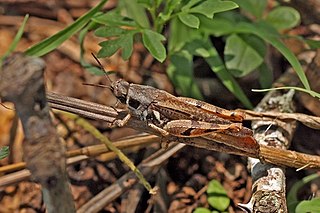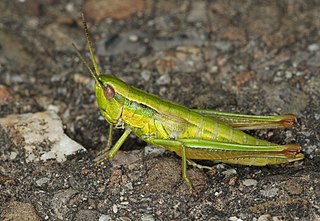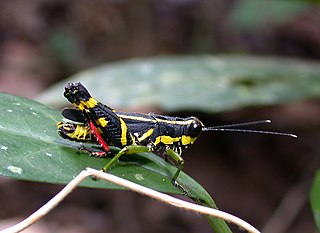
The Acrididae are the predominant family of grasshoppers, comprising some 10,000 of the 11,000 species of the entire suborder Caelifera. The Acrididae are best known because all locusts are of the Acrididae. The subfamily Oedipodinae is sometimes classified as a distinct family Oedipodidae in the superfamily Acridoidea. Acrididae grasshoppers are characterized by relatively short and stout antennae, and tympana on the side of the first abdominal segment.

The subfamily Catantopinae is a group of insects classified under family Acrididae. Genera such as Macrotona may sometimes called "spur-throated grasshoppers", but that name is also used for grasshoppers from other subfamilies, including the genus Melanoplus from the Melanoplinae. Indeed, the delimitation of these two subfamilies needs restudy: the Podismini for example are sometimes placed here, sometimes in the Melanoplinae.

Bandwings, or band-winged grasshoppers, are the subfamily Oedipodinae of grasshoppers classified under the family Acrididae. They have a worldwide distribution and were originally elevated to full family status as the Oedipodidae. Many species primarily inhabit xeric weedy fields, and some are considered to be important locusts:

The grasshopper subfamily Acridinae, sometimes called silent slant-faced grasshoppers, belong of the large family Acrididae in the Orthoptera: Caelifera.

The Melanoplinae are a subfamily of grasshoppers in the family Acrididae. They are distributed across the Holarctic and Neotropical realms. They are one of the two largest subfamilies in the Acrididae. As of 2001 the Melanoplinae contained over 800 species in over 100 genera, with more species being described continuously.

Chorthippus is a large genus of acridid grasshoppers with around 230 described species. The genus may be subdivided into subgenera including: Altichorthippus, Chorthippus and Glyptobothrus, with other species not placed.
Lucretilis is a genus of grasshoppers in the subfamily Oxyinae and tribe Oxyini. Species can be found in west Malesia.

Gomphocerinae, sometimes called "slant-faced grasshoppers", are a subfamily of grasshoppers found on every continent but Antarctica and Australia.

Oxyinae is subfamily of grasshoppers in the family Acrididae. Species are distributed throughout Africa and Australasia.

Oxyini is one of two tribes of grasshoppers in the subfamily Oxyinae. Some genera previously listed here are now placed in the subfamilies Caryandinae and Hemiacridinae.

Caryanda is large genus of grasshoppers in the subfamily Caryandinae. Species are recorded from Africa and Asia.

Podismini is a tribe of "spur-throated grasshoppers" in the family Acrididae. This tribe is unlike others in the subfamily Melanoplinae in that a substantial number of genera occur outside the Americas.

Oxya is a genus of grasshoppers found in Africa and Asia.
Cercina is a genus of Asian grasshoppers in the subfamily Caryandinae first described by Carl Stål (1833–1878), a Swedish entomologist. Species records are from Sri Lanka, Nepal and Thailand.

Traulia is a genus of grasshoppers in the subfamily Catantopinae; it was considered typical of tribe Trauliini, but is now placed in the tribe Mesambriini. A majority of species found in South-East Asia.

Phlaeoba is a genus of grasshoppers in the family Acrididae and subfamily Acridinae. The recorded distribution of species includes: India, China, Indo-China and Malesia.
Fer is a genus of grasshoppers in the subfamily Catantopinae, not assigned to any tribe. Species can be found in southern China and Vietnam.

Megaulacobothrus is a genus of grasshoppers in the tribe Stenobothrini. Species have been recorded from northern and Temperate Asia.
Svistella is an Asian genus of "sword-tail crickets", in the subfamily Trigonidiinae and has now been assigned to the tribe Trigonidiini.














